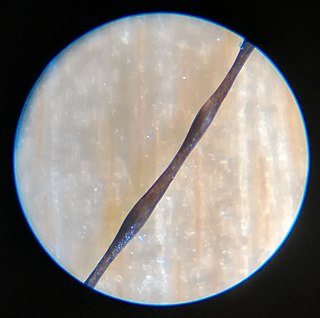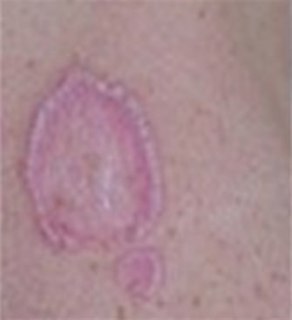
Lichen planus (LP) is a chronic inflammatory and immune-mediated disease that affects the skin, nails, hair, and mucous membranes. It is not an actual lichen, and is only named that because it looks like one. It is characterized by polygonal, flat-topped, violaceous papules and plaques with overlying, reticulated, fine white scale, commonly affecting dorsal hands, flexural wrists and forearms, trunk, anterior lower legs and oral mucosa. Although there is a broad clinical range of LP manifestations, the skin and oral cavity remain as the major sites of involvement. The cause is unknown, but it is thought to be the result of an autoimmune process with an unknown initial trigger. There is no cure, but many different medications and procedures have been used in efforts to control the symptoms.

Epidermolysis bullosa simplex (EBS), is a disorder resulting from mutations in the genes encoding keratin 5 or keratin 14.
Lichen spinulosus is a rare skin disorder characterized by follicular keratotic papules that are grouped into large patches. It is a variant of keratosis pilaris named for its resemblance to a patch of lichen.

Monilethrix is a rare autosomal dominant hair disease that results in short, fragile, broken hair that appears beaded. It comes from the Latin word for necklace (monile) and the Greek word for hair (thrix).

Elastosis perforans serpiginosa is a unique perforating disorder characterized by transepidermal elimination of elastic fibers and distinctive clinical lesions, which are serpiginous in distribution and can be associated with specific diseases.
Tufted folliculitis presents with doll's hair-like bundling of follicular units, and is seen in a wide range of scarring conditions including chronic staphylococcal infection, chronic lupus erythematosus, lichen planopilaris, Graham-Little syndrome, folliculitis decalvans, acne keloidalis nuchae, immunobullous disorders, and dissecting cellulitis.
Pincer nails are a toenail disorder in which the lateral edges of the nail slowly approach one another, compressing the nailbed and underlying dermis. It occurs less often in the fingernails than toenails, and there usually are no symptoms.
Pterygium inversum unguis is characterized by the adherence of the distal portion of the nailbed to the ventral surface of the nail plate. The condition may be present at birth or acquired, and may cause pain with manipulation of small objects, typing, and close manicuring of the nail. secondary due to connective tissue disorders
In racquet nails, the nail plate is flattened, the end of the thumb is widened and flattened, and the distal phalanx is abnormally short. In racquet nails, the width of the nail bed and nail plate is greater than their length. The condition is painless and asymptomatic.
Recurrent palmoplantar hidradenitis is primarily a disorder of healthy children and young adults, characterized by lesions that are primarily painful, subcutaneous nodules on the plantar surface, resembling erythema nodosum.
Reticular pigmented anomaly of the flexures is a fibrous anomaly of the flexures or bending parts of the axillae, neck and inframammary/sternal areas. It is an autosomal-dominant pigmentary disorder that may appear in adolescence or adulthood. This condition is due to mutations in structural/desmosomal proteins found within stratified squamous epithelium.
Tooth and nail syndrome is a rare disorder, first described in 1965, characterized by nails that are thin, small, and friable, and which may show koilonychia at birth.
Papuloerythroderma of Ofuji is a rare disorder most commonly found in Japan, characterized by pruritic papules that spare the skinfolds, producing bands of uninvolved cutis, creating the so-called deck-chair sign. Frequently there is associated blood eosinophilia. Skin biopsies reveal a dense lymphohistiocytic infiltrate, eosinophils in the papillary dermis, and increased Langerhans cells. Systemic steroids are the treatment of choice and may result in long-term remissions.
Pityriasis rotunda is a disorder of keratisation of the skin that manifests as a perfectly circular, scaly patches on the torso and proximal portions of the extremities. It may be associated with diseases like hepatocellular carcinoma in racially predisposed groups.
Papulonecrotic tuberculid is usually an asymptomatic, chronic skin disorder, presenting in successive crops, skin lesions symmetrically distributed on the extensor extremities.
Lichen myxedematosus is a group of cutaneous disorders considered mucinoses. Conditions included in this group are:

Cutaneous small-vessel vasculitis (CSVV), also known as hypersensitivity vasculitis, cutaneous leukocytoclastic vasculitis, hypersensitivity angiitis, cutaneous leukocytoclastic angiitis, cutaneous necrotizing vasculitis and cutaneous necrotizing venulitis, is inflammation of small blood vessels, characterized by palpable purpura. It is the most common vasculitis seen in clinical practice.

Cutaneous lymphoid hyperplasia refers to a groups of benign cutaneous disorders characterized by collections of lymphocytes, macrophages, and dendritic cells in the skin. Conditions included in this groups are:
Pagetoid reticulosis is a cutaneous condition, an uncommon lymphoproliferative disorder, sometimes considered a form of mycosis fungoides.
Laryngo-onycho-cutaneous syndrome is a rare epithelial disorder inherited in an autosomal recessive fashion. It is characterized by abnormalities in the larynx, nails, and skin ("cutaneous"). The disorder is only found in Punjabi Muslims and only a few cases have been reported.






